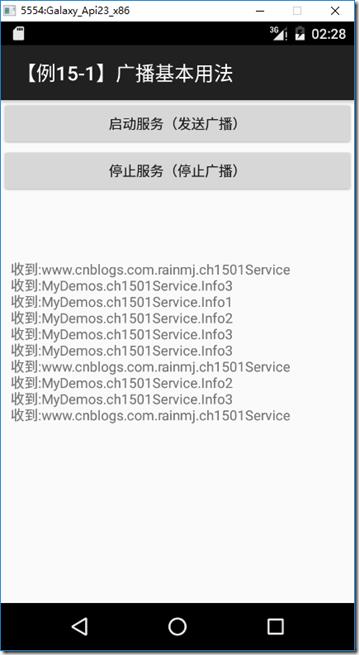Android15.2 广播
Posted
tags:
篇首语:本文由小常识网(cha138.com)小编为大家整理,主要介绍了Android15.2 广播相关的知识,希望对你有一定的参考价值。
分类:C#、android、VS2015;
创建日期:2016-02-29
一、简介
Android系统和你自己编写的应用程序都可以通过Indent发送和接收广播信息。广播的内容既可以是自定义的信息,也可以是Android的系统信息。例如,网络连接变化、电池电量变化、系统设置变化、接收到新的短信、微信、……等。
1、发送广播消息
一般都是通过后台服务中向前台发送广播消息。当然,也可以在某个Activity中向其他的Activity发送广播,不过,这种情况很少见。
要通过服务发送广播,可先定义一个继承自Service的子类,例如:
[Service]
public class MyService : Service
{
……
}
在该服务子类中,重写StartCommandResult()方法,然后在该方法中创建一个Intent实例,同时还可以调用这个Intent实例的PutExtra()方法包含要发送的附加消息(可选),最后调用SendBroadcast()方法,即可将该消息广播出去。例如:
intent = new Intent(action);
intent.PutExtra("message", "这是来自广播的消息");
SendBroadcast(intent);
注意:
(a)用Intent发送广播时,必须在参数中使用“全局唯一的标识符”指定该Intent要执行的动作,总之,你只要确保这个Action名称在整个项目中是唯一的就行了。
在实际应用中,动作字符串一般用“解决方案名+项目名+动作名”来表示,例如:
public static readonly string action = "MyBroadcastDemo.action1";
也可以用“自定义的命名空间+动作名”来表示。例如:
public static readonly string action = "www.cnblogs.com.rainmj.MyBroadcastDemo";
但是,这些都是一些约定的大家觉得比较好的做法,并不是必须这样做。换言之,唯一的要求就是不要在同一个项目中有相同的Action名称就行,这就是“全局唯一的标识符”的含义。
(b)由于发送广播一般都是通过后台服务来实现的,为了不让后台服务影响前台的界面操作,可以通过Task或者Thread来发送(见示例)。当然,如果服务用时很短,比如仅发送一个简单的字符串,那就没有必要用Task或者Thread来实现了。
发送广播的完整代码见示例中的ch1501Service.cs文件。
2、接收广播消息
对于广播接收端来说,凡是注册了BroadcastReceiver的应用程序类,都可以从继承自BroadcastReceiver的类中接收到广播消息,这个实现接收广播的BroadcastReceiver子类就叫广播接收器。
广播接收器(Broadcast Receivers)接收的广播内容一般来自Android内置的标准服务,另外,还可以来自你自己定义的服务。
例如:
public class MyBroadcastReceiver : BroadcastReceiver
{
……
}
广播接收器一旦启动,就会自动监听你注册的广播,并在OnReceive()方法中接收广播消息。因此,要正常接收广播,必须在该子类中重写OnReceive()方法,例如:
public override void OnReceive(Context context, Intent intent)
{
……
}
默认情况下,Android要求OnReceive方法必须在5秒内执行完毕,否则Android会认为该组件失去响应,并提示用户强行关闭该组件。
接收广播的完整代码见示例中的ch1501BroadcastReceiver.cs文件。
3、注册接收的广播地址
一般在Activity中注册要用哪个广播接收器来接收广播。
有两种注册接收广播地址的方式,一种是通过C#代码实现(常用),另一种是在配置文件AndroidManifest.xml中实现(不常用)。
通过C#代码实现的办法示例如下:
var receiver = new MyBroadcastReceiver();
RegisterReceiver(receiver, new IntentFilter(MyService.action));
StartService(new Intent(this, typeof(MyService)));
这段代码注册一个BroadcastReceiver,并通过IntentFilter(Intent过滤器)指定要执行的动作,然后就可以调用StartService()方法启动广播服务。
调用RegisterReceiver()后,系统就会自动在配置文件(AndroidManifest.xml)中配置Intent过滤器,不需要我们自己在这个文件中去手动配置。
二、示例1运行截图
本示例演示如何定时发送多种类型的广播。通过这个例子,相信你应该能真正理解“要发送的动作(Action)”的含义,同时也应该能明白如何在一个接收器中通过Intent过滤器注册多个动作。
该例子提前使用了下一章将要介绍的Android Service的功能。
三、主要设计步骤
1、添加ch1501_Main.axml文件
在Resource/layout文件夹下添加该文件。
<?xml version="1.0" encoding="utf-8"?> <LinearLayout xmlns:android="http://schemas.android.com/apk/res/android" android:orientation="vertical" android:layout_width="fill_parent" android:layout_height="fill_parent"> <Button android:id="@+id/ch1501_btnStart" android:layout_width="fill_parent" android:layout_height="wrap_content" android:text="启动服务(发送广播)" /> <Button android:id="@+id/ch1501_btnStop" android:layout_width="fill_parent" android:layout_height="wrap_content" android:text="停止服务(停止广播)" /> <TextView android:text="" android:textAppearance="?android:attr/textAppearanceSmall" android:layout_width="match_parent" android:layout_height="wrap_content" android:id="@+id/textView1" android:layout_marginLeft="10dp" android:layout_marginTop="50dp" /> </LinearLayout>
2、添加ch1501Service文件
在SrcDemos文件夹下添加该文件,模板选择【Class】。
using Android.App; using Android.Content; using Android.OS; using Android.Runtime; using System; using System.Threading.Tasks; namespace MyDemos.SrcDemos { [Service] public class ch1501Service : Service { public const string action1 = "www.cnblogs.com.rainmj.ch1501Service"; public const string action2 = "MyDemos.ch1501Service.Info1"; public const string action3 = "MyDemos.ch1501Service.Info2"; public const string action4 = "MyDemos.ch1501Service.Info3"; public static bool IsCancel; [return: GeneratedEnum] public override StartCommandResult OnStartCommand(Intent intent, [GeneratedEnum] StartCommandFlags flags, int startId) { //一般应根据不同的情况通过action发送不同的广播信息, //如果仅发送一条广播,像下面这样直接发送即可,不需要用Task.Run实现 //intent = new Intent(action1); //SendBroadcast(intent); //如果是长时间运行的后台服务,为了不影响界面操作,最好用 //线程来实现,比如发送后台处理的进度等。 //下面以每隔1秒随机选取一个action为例,来演示长时间运行 //的服务以及定时向前台发送不同类型广播的办法 Task.Run(async () => { Random r = new Random(); string[] actions = { action1, action2, action3, action4 }; string action = actions[0]; while (true) { if (IsCancel == true) { break; } intent = new Intent(action); SendBroadcast(intent); action = actions[r.Next(actions.Length)]; await Task.Delay(1000); } }); return StartCommandResult.Sticky; } public override IBinder OnBind(Intent intent) { return null; } } }
3、添加ch1501BroadcastReceiver.cs文件
在SrcDemos文件夹下添加该文件,模板选择【Class】。
using Android.Content; using Android.Widget; namespace MyDemos.SrcDemos { public class ch1501BroadcastReceiver : BroadcastReceiver { private TextView txt; public ch1501BroadcastReceiver(ch1501MainActivity activity) { txt = activity.FindViewById<TextView>(Resource.Id.textView1); } public override void OnReceive(Context context, Intent intent) { //此处应该对接收到的intent.Action分别进行处理 //为简单起见,例子仅将这个字符串在界面上显示出来了 txt.Text += "\\n收到:" + intent.Action; } } }
4、添加ch1501MainActivity.cs文件
在SrcDemos文件夹下添加该文件,模板选择【Activity】。
using Android.App; using Android.Content; using Android.OS; using Android.Widget; namespace MyDemos.SrcDemos { [Activity(Label = "【例15-1】广播基本用法")] public class ch1501MainActivity : Activity { private ch1501BroadcastReceiver receiver; private Intent intent; protected override void OnCreate(Bundle savedInstanceState) { base.OnCreate(savedInstanceState); SetContentView(Resource.Layout.ch1501_Main); var txt = FindViewById<TextView>(Resource.Id.textView1); IntentFilter intentFilter = new IntentFilter(); intentFilter.AddAction(ch1501Service.action1); intentFilter.AddAction(ch1501Service.action2); intentFilter.AddAction(ch1501Service.action3); intentFilter.AddAction(ch1501Service.action4); receiver = new ch1501BroadcastReceiver(this); RegisterReceiver(receiver, intentFilter); intent = new Intent(this, typeof(ch1501Service)); var btnStart = FindViewById<Button>(Resource.Id.ch1501_btnStart); btnStart.Click += delegate { txt.Text = ""; ch1501Service.IsCancel = false; StartService(intent); }; var btnStop = FindViewById<Button>(Resource.Id.ch1501_btnStop); btnStop.Click += delegate { ch1501Service.IsCancel = true; StopService(intent); }; } protected override void OnDestroy() { UnregisterReceiver(receiver); ch1501Service.IsCancel = true; StopService(intent); base.OnDestroy(); } } }
以上是关于Android15.2 广播的主要内容,如果未能解决你的问题,请参考以下文章
